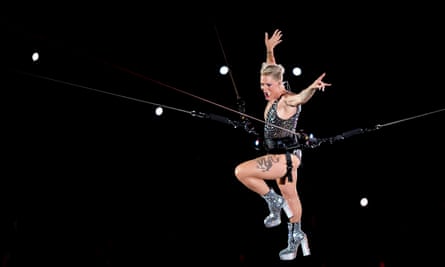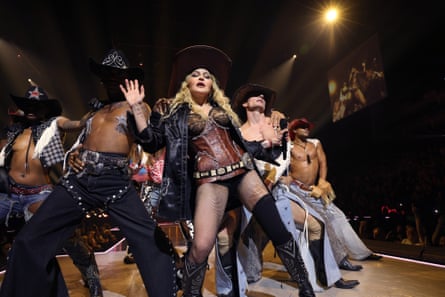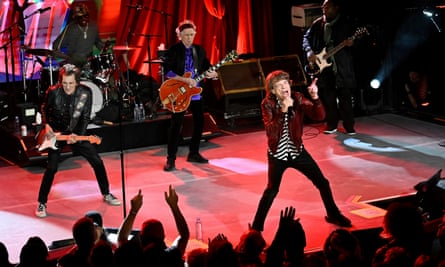
Being a pop star used to mean having a nice face and a good voice, and learning a few dance routines. That no longer cuts it at the top, as Taylor Swift reminded us last week, when she revealed how she had prepared for her Eras tour. “Every day I would run on the treadmill, singing the entire set list out loud,” she told Time magazine. “Fast for fast songs, and a jog or a fast walk for slow songs. Then I had three months of dance training, because I wanted to get it in my bones.”
If you have seen Eras live, or watched it at the cinema, you will know why she had to put in the work. Part pop extravaganza, part endurance feat, it involves almost three hours of costume changes, vigorous dancing and sprints from one end of the stage to the other – all while belting out songs. As the colour rises in Swift’s face and the sweat gathers at her hairline, you start to feel tired yourself. Swift is not unique. Beyoncé’s film Renaissance also documents the physical labour required for a tour, while 65-year-old Madonna’s current Celebration tour, which is due to conclude next April after 78 shows, makes clear how long that commitment can last.
“We treat them as athletes: what stress is going to be put on the body?” says Dan Roberts. A personal trainer based in London, he is one of a handful of fitness professionals engaged in what he calls the “weird world of celebrity training”. Most often, it involves getting actors in shape for superhero roles (or shirtless scenes); some of his clients are on Broadway, on stage for two hours a night for six months at a time. But he also works with royalty and famous musicians. Nondisclosure agreements mean he can’t name names – but he can speak generally.
Sometimes, Roberts is flown out to support an artist mid-tour, but more often he liaises with other A-list trainers around the world to look after his regular clients. And he trains those who are passing through London. His first step is to assess the needs of the individual and their goals. “Someone like Beyoncé, for example, has got very energetic dance routines, whereas Liam Gallagher can just stand there.”
Typically, the physical preparation for a tour starts three months in advance, says Roberts. Most stars are no strangers to exercise, and often present with old injuries. No one says: “My body’s great,” Roberts says. “You have to work around that.” Another personal trainer, Jono Castano, who is based in Sydney, agrees. “A lot of them know what they need to do: what to eat, how to train. It’s about reminding them and keeping them accountable.”
“Prehabilitation” work, which means building flexibility and all-round strength, is vital for preventing injury when dancing night after night. Roberts focuses on the stabiliser muscles around the ankles, “and other stuff that is more likely to get knackered”. There is rarely a need to bulk up, though Roberts had one pop star client whose body fat was too low for her to safely exert herself night after night. “She was getting away with it in terms of health, but she wasn’t menstruating, which is always a warning sign. I knew the tour was going to be hard on her, because she didn’t eat that much when she was stressed.”
The goal, in that case, was to increase her body fat and maintain it for the duration of the tour. But beyond the demands of consecutive nightly performances, there is often a less obvious “secondary goal”, says Roberts, such as losing weight or gaining muscle before a red-carpet appearance or film role. “Increasingly, these people are brands, and they have to do multiple things.”
Rita Ora, a client of Castano, often arrived at sessions feeling tired, “which is understandable”, he says. “But seeing the benefits of what a training session does, releasing endorphins, she left feeling so much better and more positive.” Even the sympathetic ear of a trainer, “just listening to them, giving advice on whatever that day held”, can be valuable, he says. “I always say: if you can’t put aside 45 minutes for yourself each day, then we need to take a look inside.” For some celebrities, working out is even “kind of an escape”.

As well as being an ad hoc therapist, the trainer has to recognise and accommodate the nuanced demands of the star’s schedule. For those at Swift’s level, that could mean the trainer serving as one cog in a “well-oiled machine”, says Roberts. Their every need is catered for. “It’s like a company.” Swift’s team, for example, might be made up of as many as 40 full-time personnel, with dozens more contracted for tours. A big undertaking like the Eras tour might extend to daily massages, routine strength and fitness assessments, and nutrition that meets the star’s exact requirements.
Sometimes, the most challenging part of the trainer’s job is convincing the star that they have something to offer them. Stars at the level of Mick Jagger and Madonna, who have given over their lives to performing, can be “complete control freaks”, says Roberts. “That’s not an insult. It’s why they’re so ridiculously successful. But it’s very hard coming into that as a trainer, no matter how good you think you are, because as soon as you make a stand, you’ll get fired.”
While performers are on the road, workouts are often pared back to maintenance level and rest days are built into the schedule to protect the star’s energy and wellbeing. Roberts estimates that they might burn 1,000 calories in a single show, or even two or three times that. But it is not the same exertion as if the average person, or even someone very fit like Roberts, were to take the stage. He has never worked with Swift, but guesses that, for her, a three-hour show might be like running 5km for many of us: tiring but not annihilating. “She’s built those muscles and energy levels up over the past 15 years.” Some artists seem verging on superhuman. Pink, known for the aerial acrobatics in her shows, does an hour of cardio and an hour of yoga before taking to the stage. “Sometimes I feel more like an athlete than a singer,” she has said.

Before a performance, more acrobatic vocalists might limit conversation. And superstars rarely party afterwards, says Roberts, motivated by the need to protect their brand as much as their instrument. “They have their honey tea or whatever, go to bed early, get their rest.”
“You see what the artists go through, and it’s immense,” says Niamh McCarthy, the founder of Mindful Nation, a meditation app designed for artists. In her previous life, McCarthy spent four years on the road with U2 as their assistant manager, while also jetting over to support Madonna as needed. Having left the touring life behind, she is not surprised to see younger stars, including Justin Bieber and Shawn Mendes, cancelling concerts to focus on their wellbeing. “Not only are they expected to go on stage and give it their all every night, but a lot of after-show things are obligatory: your label and publishing companies want to see you and talk. They’re just so busy.”
But today’s image-conscious artists “aren’t going to ruin their reputation or cancel a show because they’re hungover. They’re too professional,” says Roberts. Only a few of his clients have lived up to the hard-living, hard-drinking cliche, and “they were in rock bands, where they don’t give a shit about how they look”. That, too, had to be taken into account in training. Roberts recalls working with a singer who refused a protein shake because it contained additives. “I told him: ‘Mate, you had four lines of coke last night, and it was a Tuesday – get your priorities right.’”



